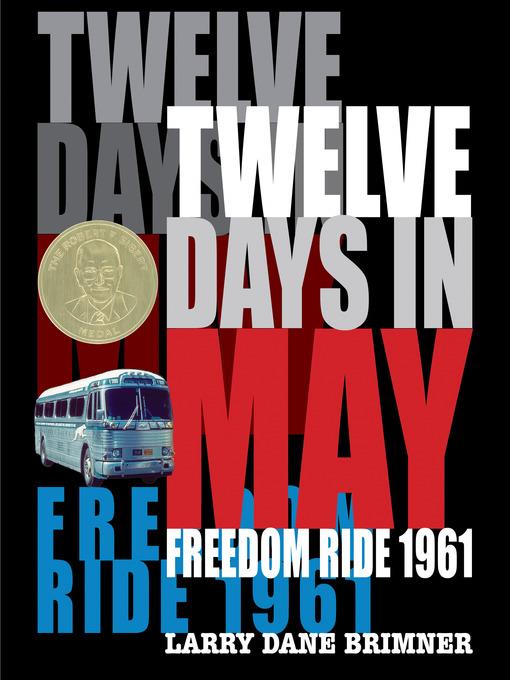
Twelve Days in May
Freedom Ride 1961
فرمت کتاب
ebook
تاریخ انتشار
2017
Lexile Score
1080
Reading Level
5
ATOS
7
Interest Level
4-8(MG)
نویسنده
Larry Dane Brimnerشابک
9781629799179
کتاب های مرتبط
- اطلاعات
- نقد و بررسی
- دیدگاه کاربران
نقد و بررسی

September 18, 2017
Using a straightforward, present-tense narrative and a diary-style format, Brimner (The Rain Wizard) recounts the first freedom ride of the civil rights movement. After opening with a recap of several landmark court cases that affected civil rights for African-Americans, the third-person retrospective begins a day-by-day account of the bus journey in May 1961: “They are men and women, young and old, black and white. They are people with a plan.... They are prepared for the unexpected.” The 13 riders, all promising nonviolence, left Washington, D.C., aboard two buses bound for Louisiana in an effort to integrate interstate travel facilities. The further south they traveled, the more violent local reaction became. Black typeface on white pages alternates with white typeface against black backdrops to stark effect, and words taken from quotations, segregation signs, or slogans from the ride occasionally pop out from the pages. Archival photos depict the ride and violent confrontations, including the firebombing of one bus. This well-researched and accessible account of a precedent-setting protest ends with an epilogue, updates on the 13 riders, a bibliography, source notes, and index. Ages 10–up.

Starred review from September 1, 2017
Gr 5 Up-An engaging and accessible account of the 13 original Freedom Riders as they attempted to make their way from Washington, DC, to New Orleans, LA, to celebrate the seventh anniversary of the Brown v. Board of Education decision. The riders, "men and women, young and old, black and white," planned to sit anywhere they liked on the buses and to make use of all facilities available at bus stations. Despite federal laws prohibiting segregated seating and facilities serving interstate passengers, many parts of the South ignored these laws and continued to enforce Jim Crow segregation. As they traveled, white Freedom Riders used "Colored" facilities and black Freedom Riders used "White" facilities. The farther south they went, the more intense and violent the opposition they faced. Despite their commitment to nonviolence, the Freedom Riders were attacked and beaten, and by the time they made it to Alabama, their bus was fire bombed and several riders sustained serious injuries. Brimner, author of several other books about civil rights in this era, knows the material well and presents a straightforward narrative approach to the subject that will appeal to readers. The stark, black-and-white design of the text emphasizes the directness of the prose, while the riveting, full-page photos and descriptive captions enhance the reading experience. VERDICT An essential part of civil rights collections and a worthy addition to all nonfiction shelves.-Kristy Pasquariello, Wellesley Free Library, MA
Copyright 2017 School Library Journal, LLC Used with permission.

August 1, 2017
Even after some Jim Crow laws were declared unconstitutional, many states continued to refuse to adhere to the changes. Sibert Honor-winning author Brimner (Black and White, 2011) explores the first "Freedom Ride" in May 1961, as seven black and six white activists ranging in age from 18 to 61 set out to bring attention to this resistance. Recruited by the Congress of Racial Equality, they left Washington, D.C., on commercial buses, planning to arrive in New Orleans on May 17 to celebrate the seventh anniversary of Brown v. Board of Education. As they traveled south, they encountered expected resistance. White Freedom Riders were denied service at colored-only lunch counters. Joseph Perkins, a black rider, attempted to get a shoeshine in the "white chair" and, when he refused to move, was arrested. As the bus continued south, the responses to the riders became increasingly more violent. Three of the group, including John Lewis, were severely beaten even though they remained nonviolent. As they approached Birmingham, Alabama, they were met by the Ku Klux Klan and abandoned by law enforcement. Brimner does an excellent job giving the necessary context for the events, and the day-by-day focus provides dramatic tension for the narrative. Useful backmatter includes biographical sketches, bibliography, source notes, index, and picture credits. Richly illustrated with period photographs and strikingly designed, this is a clear, accessible depiction of a major story in the civil rights movement. (Nonfiction. 10-18)
COPYRIGHT(2017) Kirkus Reviews, ALL RIGHTS RESERVED.

Starred review from October 15, 2017
Grades 6-9 *Starred Review* On May 4, 1961, 13 Freedom Riders board two buses in Washington, D.C., hoping to reach New Orleans and planning to practice nonviolent resistance of illegal Jim Crow practices along the way. Black and white men and women of varied ages, they share a commitment to ending segregation and the courage to put themselves in harm's way. While their first encounters are minor, as they travel south, arrests and intimidation increase, culminating in mob violence and the firebombing of one bus. The 1961 Freedom Riders helped bring conditions in the South to national attention, increasing public support for stronger civil rights laws and enforcement. Brimner, whose books on the civil rights era include Birmingham Sunday (2010) and Black and White (2011), presents a tightly focused, present-tense account of what happened during the May 1961 Freedom Rides. Presented on spacious pages with striking design, the many large, archival black-and-white photos transport readers back in time. While the introductory and concluding sections offer helpful summaries of four major Supreme Court rulings on segregation from 1896 to 1960 and short biographies of the 13 Freedom Riders, the heart of the book is its straightforward, concise, day-by-day reporting of the journey. A memorable presentation of inherently dramatic and historically significant events.(Reprinted with permission of Booklist, copyright 2017, American Library Association.)

























دیدگاه کاربران